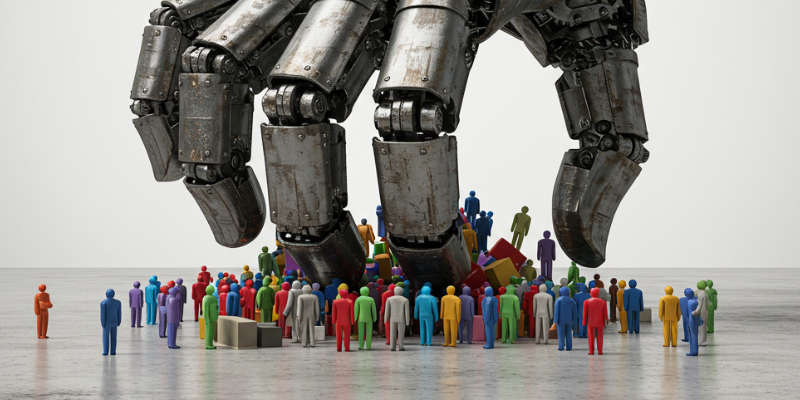The Hidden Burden of Employer Regulations: a System of Control?

Governments often justify heavy regulations on employers by claiming they protect workers and ensure economic stability. However, these regulations frequently serve as hidden mechanisms to extract wealth from businesses and workers, funneling money into government-controlled systems rather than directly benefiting employees. Mandatory pensions, insurance schemes, and rigid labor laws do little more than restrict economic freedom, reduce take-home pay, and trap workers in a cycle of low wages and dependency. This raises the question: are these regulations truly for the people, or are they another method to increase state control over labor and finances?
The Illusion of Benefits: Forced Pensions and Insurance
A System That Does Not Benefit Workers
One of the most significant financial burdens on employers is the mandatory pension and insurance schemes. Employers are required to contribute substantial amounts to pension funds and insurance programs that workers may never fully utilize. Many employees die before reaching the age at which they can collect full pensions, effectively losing out on the money they contributed throughout their careers (OECD, “Pensions at a Glance”, 2023).
Insurance contributions, including unemployment insurance, disability insurance, and health coverage, further eat into both employer and employee incomes. These schemes often provide minimal benefits relative to the amount contributed, with bureaucratic inefficiencies and mismanagement leading to a system where only a fraction of collected funds are returned to those who need them (Financial Times, “The Pension Black Hole”, 2023).
Where Does The Money Go?
Rather than serving workers, these contributions primarily fund massive state-run programs, many of which are unsustainable due to demographic shifts and increasing government debt. In reality, these schemes function as another form of taxation, where workers are forced to contribute without real choice or clear benefits (IMF, “The Future of Social Security”, 2023).
Restrictive Hiring Laws: Stifling Business andLlimiting Opportunities
A Job Market Controlled by Red Tape
Employment laws are often presented as measures to protect workers, but they create significant barriers for businesses, particularly small enterprises. High severance pay, rigid contract laws, and bureaucratic hiring processes discourage companies from expanding their workforce. In many cases, businesses opt for temporary contracts, low-wage positions, or outsourcing to avoid the financial and legal risks associated with full-time employees (World Economic Forum, “Employment Regulation and Economic Growth”, 2023).
How regulations trap workers in low-paying jobs
Due to these restrictive regulations, companies are less willing to take risks in hiring, leading to a rise in precarious employment situations. Many workers are left with temporary or gig-based contracts that offer little stability or long-term prospects. Rather than empowering workers, labor laws often lock them into cycles of job insecurity, reducing their negotiating power and career growth opportunities (Forbes, “The Gig Economy Trap”, 2023).
Minimum wage laws and taxation: making work less rewarding
The minimum wage paradox
While minimum wage laws are meant to guarantee fair pay, they often have the opposite effect. Businesses facing higher labor costs frequently reduce their workforce, automate jobs, or relocate to countries with lower wages. This results in fewer employment opportunities, particularly for young or inexperienced workers who struggle to enter the job market (Cato Institute, “The Unintended Consequences of Minimum Wage Laws”, 2023).
The silent tax on workers
In addition to reducing employment opportunities, wage regulations contribute to increased taxation. Governments impose high income taxes and social contributions, further reducing the real earnings of employees. Many workers receive only a fraction of the money their employers pay for their labor, with the majority siphoned off into tax and regulatory systems that offer little direct return (Tax Foundation, “The True Cost of Employment Taxes”, 2023).
A system designed to control, not empower
Economic dependence and government control
By mandating extensive employer contributions and overregulating the labor market, governments create a system in which both businesses and employees remain economically dependent on state programs. This prevents individuals from building financial independence and limits entrepreneurial activity, ensuring continued reliance on government intervention (Heritage Foundation, “The Regulatory State and Economic Freedom”, 2023).
Who truly benefits?
The primary beneficiaries of these regulations are not workers, but governments and large corporations that can absorb these costs while smaller businesses struggle. By controlling the flow of money through mandatory pensions, insurance, and labor laws, governments ensure they maintain influence over the workforce while suppressing economic freedom and innovation (Mises Institute, “Regulatory Capture and the Illusion of Worker Protections”, 2023).
Conclusion
The idea that heavy employment regulations protect workers is largely a myth. Instead, they serve as a mechanism for state control, siphoning wealth from businesses and employees under the guise of security and stability. These regulations reduce take-home pay, limit job opportunities, and stifle economic growth, ultimately benefiting governments and large corporate interests rather than the people they claim to protect. If economic freedom is to be preserved, it is essential to challenge these policies and advocate for a system that allows businesses and workers to operate with greater flexibility and financial autonomy.
References
- OECD, “Pensions at a Glance”, 2023.
- Financial Times, “The Pension Black Hole”, 2023.
- IMF, “The Future of Social Security”, 2023.
- World Economic Forum, “Employment Regulation and Economic Growth”, 2023.
- Forbes, “The Gig Economy Trap”, 2023.
- Cato Institute, “The Unintended Consequences of Minimum Wage Laws”, 2023.
- Tax Foundation, “The True Cost of Employment Taxes”, 2023.
- Heritage Foundation, “The Regulatory State and Economic Freedom”, 2023.
- Mises Institute, “Regulatory Capture and the Illusion of Worker Protections”, 2023.


















